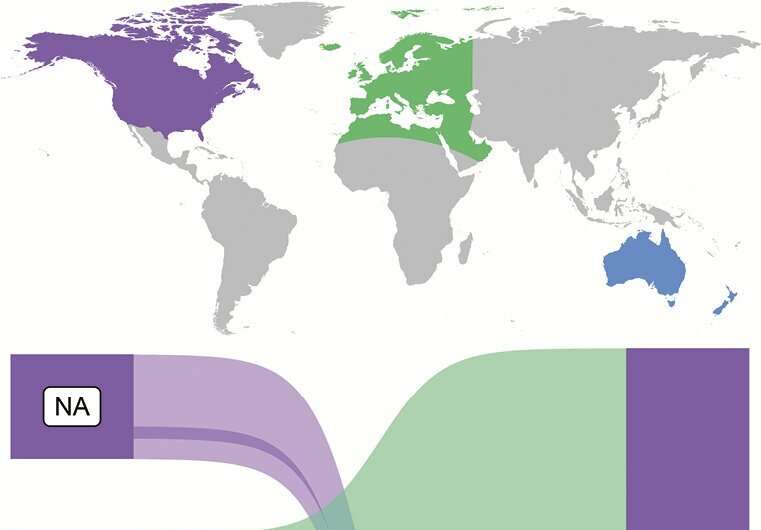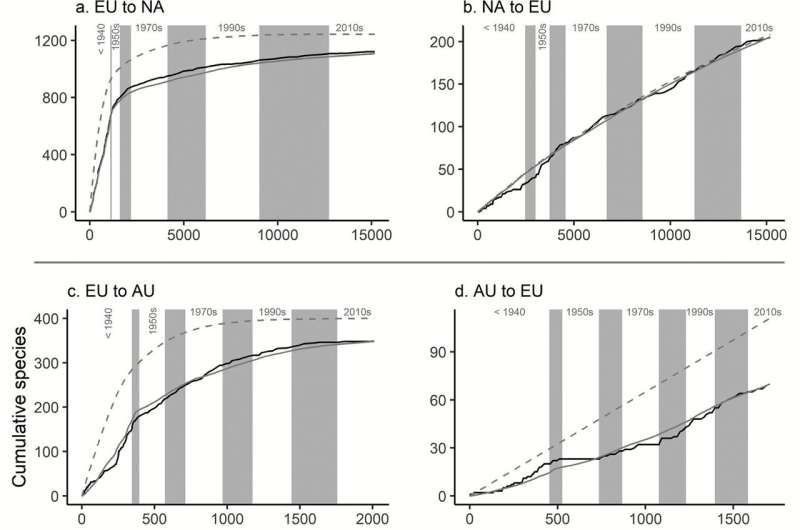This article has been reviewed according to Science X's editorial process and policies. Editors have highlighted the following attributes while ensuring the content's credibility:
fact-checked
peer-reviewed publication
trusted source
proofread
European insects spread across the world. Was it because settlers carried plants?

Insects are among the most prolific and successful invaders of new habitats, but not all regions are equal in the numbers of insects that have spread beyond their borders.
European insects, in particular, stand out as highly successful invaders into other world regions. Why? Biologists have long understood that species are spread through international trade: Insects are frequent stowaways in trade goods, and the value of international trade between world regions can be a good predictor of how many non-native species are exchanged.
However, recent research led by Dr. Rylee Isitt of the University of New Brunswick, and published in the journal NeoBiota, shows that after accounting for patterns of international trade, the number of insects that have spread from Europe into North America, Australia, and New Zealand far exceeds expectations.
Since patterns in international trade can't explain these insect invasions, the researchers looked for other potential explanations. It's possible that European insects are simply more numerous or better invaders than their North American or Australasian counterparts. However, Dr. Isitt and his collaborators didn't find evidence for that—at most, there are only slightly more European species with the capacity to invade compared to North American and Australasian species.

Another possibility is North American and Australasian habitats are easier to invade than European ones. But prior research has shown that Europe has been heavily invaded by Asian insects, suggesting that it is no more resistant to invasion than North America or Australasia.
Instead, Dr. Isitt and collaborators have proposed that the abundance of European insect invaders may be a result of deliberate introductions of non-native plants into Europe's colonies. Plants introduced into European colonies could have promoted the spread of European insects into North America and Australia by two different means.
First, insects may have been introduced along with the plants. Second, introduced plants may have provided suitable food and habitat for subsequent arrivals of non-native insects, who might have otherwise found the native flora to be unpalatable or unsuitable as a habitat.
Although the researchers haven't completely resolved the mystery of the overabundance of European insects, they have ruled out several possibilities, leaving the connection to introduced plants as the prime suspect. The next steps? Determining to what extent European insects spread through introduced plants compared to insects from other world regions.
Because invasive species are reshaping our world, we need to understand how they move and establish. Evidence is mounting that trade in plants and plant products is responsible for a large proportion of insect invasions. If the researchers' hypothesis is correct, the spread of European insects may be a remarkable example of the unintended consequences of deliberate plant introductions.
More information: Rylee Isitt et al, Asymmetrical insect invasions between three world regions, NeoBiota (2024). DOI: 10.3897/neobiota.90.110942
Journal information: NeoBiota
Provided by Pensoft Publishers



















